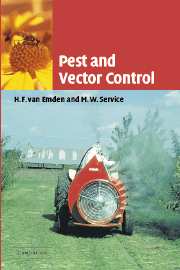Book contents
- Frontmatter
- Contents
- Preface
- 1 Man and insects
- 2 The causes of pest and vectored disease outbreaks
- 3 Insecticides and their formulation
- 4 Application of insecticides
- 5 Problems with insecticides
- 6 Environmental/cultural control
- 7 Biological control
- 8 Insect pathogens
- 9 Genetic control
- 10 Pheromones
- 11 Plant and host resistance
- 12 Other control measures and related topics
- 13 Pest and vector management
- Appendix of names of some chemicals and microbials used as pesticides
- References
- Index
6 - Environmental/cultural control
Published online by Cambridge University Press: 03 December 2009
- Frontmatter
- Contents
- Preface
- 1 Man and insects
- 2 The causes of pest and vectored disease outbreaks
- 3 Insecticides and their formulation
- 4 Application of insecticides
- 5 Problems with insecticides
- 6 Environmental/cultural control
- 7 Biological control
- 8 Insect pathogens
- 9 Genetic control
- 10 Pheromones
- 11 Plant and host resistance
- 12 Other control measures and related topics
- 13 Pest and vector management
- Appendix of names of some chemicals and microbials used as pesticides
- References
- Index
Summary
Introduction
Mankind had to try and manage insect problems for centuries before insecticides became available, biological control was purposefully introduced or the many other approaches described in this book were developed. The mainstay of these earlier efforts was to make the environment unfavourable for the development of pests. For human and animal disease vectors, the environment was usually the wild vegetation around habitations as well as the habitations themselves, and the term ‘Environmental control’ is generally used in these contexts.
The same phrase is, however, virtually unknown to agricultural entomologists. For them, the environment which is to be made less favourable for the pest is, more often than not, a crop, and the techniques of environmental modification are manipulations of the various cultural practices (ploughing, planting, harvesting etc.) carried out by farmers. Pest control based on these practices is always called ‘Cultural control’; therefore we have used the two words ‘Environmental’ and ‘Cultural’ in the heading to this chapter. It should be pointed out that there is yet another aspect of ‘Environmental control’, where the microclimate in closed systems (e.g. grain-storage containers) is made lethal to pest organisms. This aspect is dealt with in Chapter 12 among ‘Physical methods’.
History of environmental/cultural control
As pointed out in the Introduction, these controls were mankind's chief weapon against pests before the arrival of the powerful modern synthetic pesticides, and thus represent most pest control used in the long history of our war against insects.
- Type
- Chapter
- Information
- Pest and Vector Control , pp. 123 - 146Publisher: Cambridge University PressPrint publication year: 2004

